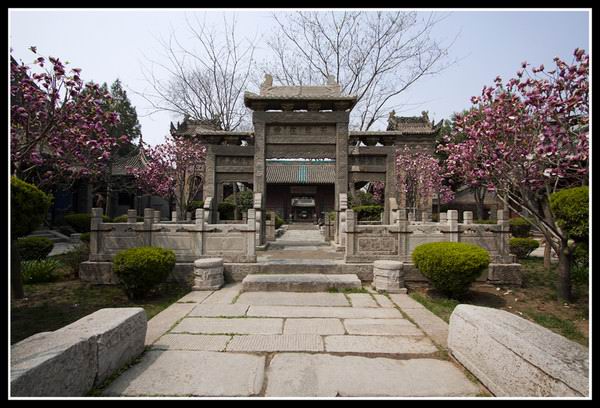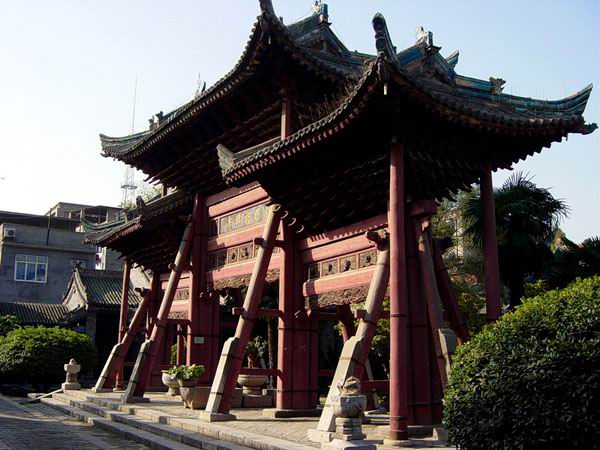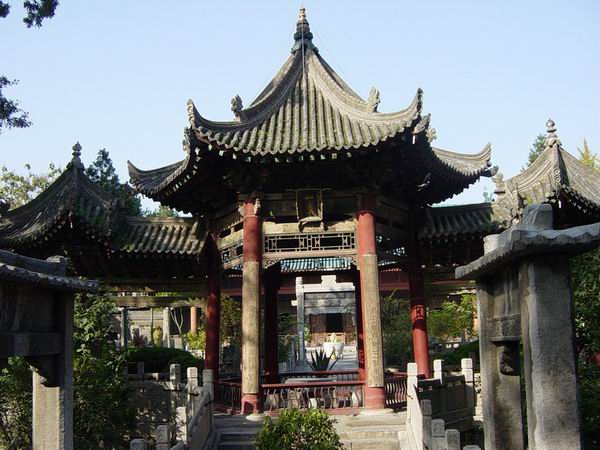The Great Mosque
Brief Introduction
The great mosque is located near the Drum Tower and branches off from the West Street. It is major spot for the religious activities of over 60,000 Moslems in Xi’an. It is also an important historic monument in Shaanxi Province.
Most of the Islamic mosques have splendid domes and minarets reaching to the clouds, but this one is very different from others. It is much more like a Chinese garden or temple with pavilions, painted beams and engraved ridgepoles.
This mosque is the largest in Xi’an, and at the same time, it is one of the earliest built on a comparatively large scale, and well preserved in China. It is located in this Islamic quarterinhabited by the Huis. The mosque is believed to be built as early as in the Tang dynasty (618AD-907AD). The buildings now accessible to visitors date from the Ming Dynasty(1368A1644AD), and have been restored several times. The complex consists of four courtyards laid out on an east-west axis, and covers an area of 12,000 square meters.
Background Knowledge
The Religion of Islam
The word Islam means submissions, that is to say, the true Moslem is supposed to submit his life to the divine will of the God. Islam, the world’s youngest universal and the second largest faith,was founded in the early 7th century AD by the Arab Prophet Mohammed. It has 750 followers. Eight words can sum up the central belief of the Moslems ‘There is no God but God, Mohammed is the messenger of the God’. The eight words are recited by devotee the world over five times a day when the muezzins summon them to worship God. All Moslems accept Koran as God’s eternal word, though there are some divisions not so many as those of the Christianity.
When and how were Islam spread to China, and developed to such a large group?
It should be traced back to the mid-7th century in the Tang Dynasty. At that time, Tang Dynasty was in such a prosperous state that it attracted many Arabian merchants and travelers to establishdiplomatic, trade, and military contacts with China. They passed through Persia and Afghanistanto reach the northwest region of China. Some of them came to Quanzhou, Hangzhou, Guangzhou and other seaside cities because they started their travel from the Bangladesh Bay and crossed the Strait of Malacca. Many of them settled down in China and get married with Chinese women, and their children became the original Moslems in China. However, the massive immigration of Moslems started in the 13th century when Genghis Kan conquered vast expenses of landstretching from the Central Asia to Eastern Europe, and set up Yuan Dynasty. A large number of Moslems including artisans and soldiers were conscribed and later moved to China. They were all called ‘Hui’ by the Chinese people. Hui in Chinese means Go Back. Maybe they always missed their home and wanted to go back.
Many Moslems joined Kublai Khan in his war for the unification of China, so they held positions both in the military and civilian organs of the country. A lot of them took part in Zhu Yuanzhang’s rebellion against government at the end of the Yuan Dynasty. Therefore, after Zhu established the Ming Dynasty, he ordered to protect Islam and set up many mosques for the Moslems in many cities. In the 16th century, Islam predominated Xinjiang and spread its influence to Gansu, Ningxia and Qinghai.
Today Islam has a large following among ten of China’s minority groups. The Moslems in Xi’an are mainly the Huis, being a small portion of the 17 million in China.
Mosems in China Now

Freedom of religious belief is a basic and long term policy of the Chinese government. The Moslems have the same rights as other Chinese, and their religious belief is protected by the state law. They do the same thing as their brothers and sisters do everywhere in the world. They worship the God five times a day respectively at dawn, at noon, in the afternoon, at dusk, and at night. They take a bath before worshiping. They pay more attention to their health and always wear clean clothes. They are not supposed to drink wine or eat port, for in Koran, pork have been mentioned as unclean four times.
The First Coutryard
Wall Screen
There is a huge wall screen over there. It is called ‘Zhao Bi’ in Chinese. It is a unique architecturestyle in courtyard in China. It is said in ancient times, people believed ghosts would often come to visit their houses, so they set up Zhaobi to stop the ghosts. Actually the function of the screen is to prevent people outside the houses from seeing the inside houses to protect the privacy of the house owners. Most wall screens are carved with beautiful patterns as decorations.
Wooden Memorial Arch 
It was built at the turn of the 17th century. It is about nine meters high and has a history of 360 years. The four words on the top of it mean the mosque was built in the order of the emperor.Memorial arches usually stand in broad view outside cities, in front of temples or tomb complexes and on park and palaces as landmarks. They were also erected on imperial order tohonor or commemorate an outstanding and famous person.
The Second Courtyard
In the centre of the second courtyard, there are two tall tablets with dragons carved on each. They record the details of the repair work ever conducted since the building or the mosque. This one bears the characters written by a famous Song Dynasty calligrapher Mi Fu: ‘May Islam fill the universe’. And this one bears the characters written by a Ming Dynasty calligrapher Dong Qichang: ‘Royally Bestowed’. These characters are typical examples of traditional Chinese calligraphy.
The Third Courtyard
The three-storey wooden building in front of us is called ‘Xing Xin lou’ meaning ‘Retrospection Tower’. It is used as the same function of the minaret in Arabic mosques to send orders to the Moslems to come to worship. Respectively on the south and north wings of the Retrospection Tower are the Reception chamber and the Scripture Chamber in elegant layout. The five wooden houses are the ‘Water Houses’ in which the Moslems take baths before they go to worship.
The Fourth Courtyard

The magnificent wooden building in the center is called ‘Phoenix Pavilion’. The main complex is flanked by two three-gabled buildings, just looking like a flying phoenix, hence its name. It is used for worshippers to wait for services.
On the left hand is a reception hall, which used to be a place to receive high officials who bringing the emperor’s orders to the mosque in ancient times. Now it displays twelve ancient decoration screens, and some Ming and Qing dynasty furniture.
The hall behand the ‘Phoenix Pavilion’ is the the main Prayer Hall, which is the main structure of the mosque. It covers an area of 1,300 square meters and can hold over 1,000 worshippers at a time. The five clocks on the wall show the five exact times for the believers to worship. The believers come here at 13:10 every day, and the other four times rely on the weather and season.The ceiling is painted with over 600 relief panels. The walls of the hall, as well as the panels, are decorated with patterns of trailing plants and Arabic letters. The thirty relief carvings on the wall are a complete Koran, which has amazed many Moslems overseas. They haven’t seen such a Koran totally in relief carvings. The minbar, also a shrine at the western end of the hall is where imam and worshipers chant the Koran, leads his worshippers to chant Koran while facing in the direction of Mecca.
Tips
|
Location
|
Huajue Lane, west of the Drum Tower of Xi’an
|
|
Drive Distance
|
In the center of the city
|
|
Opening Time
|
8:00 to 19:00
|
|
Ticket Price
|
Mar-Nov: RMB 25yuan per person
|
|
Dec-Feb: RMB 15yuan per person
|
|
Visiting Time
|
one hour
|











